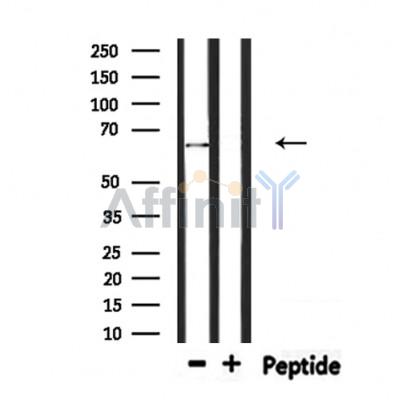ATIC Antibody - #DF7399
| Product: | ATIC Antibody |
| Catalog: | DF7399 |
| Description: | Rabbit polyclonal antibody to ATIC |
| Application: | WB IHC |
| Reactivity: | Human, Mouse, Rat |
| Prediction: | Pig, Zebrafish, Bovine, Horse, Sheep, Rabbit, Dog, Chicken, Xenopus |
| Mol.Wt.: | 64kDa; 65kD(Calculated). |
| Uniprot: | P31939 |
| RRID: | AB_2839337 |
Related Downloads
Protocols
Product Info
*The optimal dilutions should be determined by the end user. For optimal experimental results, antibody reuse is not recommended.
*Tips:
WB: For western blot detection of denatured protein samples. IHC: For immunohistochemical detection of paraffin sections (IHC-p) or frozen sections (IHC-f) of tissue samples. IF/ICC: For immunofluorescence detection of cell samples. ELISA(peptide): For ELISA detection of antigenic peptide.
Cite Format: Affinity Biosciences Cat# DF7399, RRID:AB_2839337.
Fold/Unfold
AICAR formyltransferase/IMP cyclohydrolase; 5 aminoimidazole 4 carboxamide 1 beta D ribonucleotide transformylase/inosinicase; 5 aminoimidazole 4 carboxamide ribonucleotide formyltransferase; 5 aminoimidazole 4 carboxamide ribonucleotide formyltransferase/IMP cyclohydrolase; 5-aminoimidazole-4-carboxamide ribonucleotide formyltransferase; AICAR; AICAR formyltransferase/IMP cyclohydrolase bifunctional enzyme; AICAR transformylase; AICARFT; AICARFT/IMPCHASE; ATIC; Bifunctional purine biosynthesis protein PURH; epididymis secretory sperm binding protein Li 70p; FLJ93545; HEL-S-70p; IMP cyclohydrolase; IMP synthase; IMP synthetase; IMPCHASE; Inosinicase; OK/SW-cl.86; Phosphoribosylaminoimidazolecarboxamide formyltransferase; Phosphoribosylaminoimidazolecarboxamide formyltransferase/IMP cyclohydrolase; PUR9_HUMAN; PURH;
Immunogens
A synthesized peptide derived from human ATIC, corresponding to a region within C-terminal amino acids.
- P31939 PUR9_HUMAN:
- Protein BLAST With
- NCBI/
- ExPASy/
- Uniprot
MAPGQLALFSVSDKTGLVEFARNLTALGLNLVASGGTAKALRDAGLAVRDVSELTGFPEMLGGRVKTLHPAVHAGILARNIPEDNADMARLDFNLIRVVACNLYPFVKTVASPGVTVEEAVEQIDIGGVTLLRAAAKNHARVTVVCEPEDYVVVSTEMQSSESKDTSLETRRQLALKAFTHTAQYDEAISDYFRKQYSKGVSQMPLRYGMNPHQTPAQLYTLQPKLPITVLNGAPGFINLCDALNAWQLVKELKEALGIPAAASFKHVSPAGAAVGIPLSEDEAKVCMVYDLYKTLTPISAAYARARGADRMSSFGDFVALSDVCDVPTAKIISREVSDGIIAPGYEEEALTILSKKKNGNYCVLQMDQSYKPDENEVRTLFGLHLSQKRNNGVVDKSLFSNVVTKNKDLPESALRDLIVATIAVKYTQSNSVCYAKNGQVIGIGAGQQSRIHCTRLAGDKANYWWLRHHPQVLSMKFKTGVKRAEISNAIDQYVTGTIGEDEDLIKWKALFEEVPELLTEAEKKEWVEKLTEVSISSDAFFPFRDNVDRAKRSGVAYIAAPSGSAADKVVIEACDELGIILAHTNLRLFHH
Predictions
Score>80(red) has high confidence and is suggested to be used for WB detection. *The prediction model is mainly based on the alignment of immunogen sequences, the results are for reference only, not as the basis of quality assurance.
High(score>80) Medium(80>score>50) Low(score<50) No confidence
Research Backgrounds
Bifunctional enzyme that catalyzes 2 steps in purine biosynthesis.
Promotes insulin receptor/INSR autophosphorylation and is involved in INSR internalization.
The IMP cyclohydrolase activity resides in the N-terminal region.
Belongs to the PurH family.
Research Fields
· Human Diseases > Drug resistance: Antineoplastic > Antifolate resistance.
· Metabolism > Nucleotide metabolism > Purine metabolism.
· Metabolism > Metabolism of cofactors and vitamins > One carbon pool by folate.
· Metabolism > Global and overview maps > Metabolic pathways.
Restrictive clause
Affinity Biosciences tests all products strictly. Citations are provided as a resource for additional applications that have not been validated by Affinity Biosciences. Please choose the appropriate format for each application and consult Materials and Methods sections for additional details about the use of any product in these publications.
For Research Use Only.
Not for use in diagnostic or therapeutic procedures. Not for resale. Not for distribution without written consent. Affinity Biosciences will not be held responsible for patent infringement or other violations that may occur with the use of our products. Affinity Biosciences, Affinity Biosciences Logo and all other trademarks are the property of Affinity Biosciences LTD.




